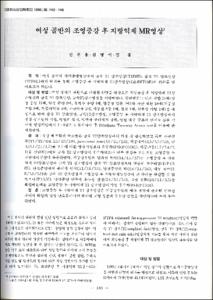여성 골반의 조영증강 후 지방억제 MR영상
- Keimyung Author(s)
- Kim, Jung Sik; Kim, Hong
- Department
- Dept. of Radiology (영상의학)
- Journal Title
- 대한방사선의학회지
- Issued Date
- 1998
- Volume
- 39
- Issue
- 1
- Abstract
- Purpose : To compare the value of Gd-DTPA enhanced, fat-suppression T1-weighted (Gd-FST1SE) MR images in thediagnosis of female pelvic disorders with that of fast spin-echo T1-weighted(T1FSE) and fast spin-echoT2-weighted(T2FSE) MR images. Materials and Methods : Pelvic MR images of 42 women (24 ovarian disorders, 19uterine disorders) were reviewed by two radiologists. Discrimination of normal anatomic structures, identificationof pathologic lesions and recognition of internal structure of the lesions such as solid and cystic portion,papillary nodule, septa and wall were evaluated using a scoring system. The Friedman two-way ANOVA test was usedfor data analysis. Results : T2FSE was useful for evaluation of the uterine cervix(T1/T2/Gd, 2.5/3.9/2.8,respectively), junctional zone(1.6/3.1/2.5), endometrium (2.0/3.3/3.0), ovary(1.1/2.1/1.7) and uterine myoma(1.7/2.4/2.1)(P<0.001), but secondary degeneration was best visualized on Gd-FS T1SE. The Gd-FS T1SE ;lymphadenopathy(3.4/1.5/3.7) was better visualised on this modality than on eithor TIFSE or T2FSE. Gd-FS T1SEimages also clearly depicted papillary projection(2.4/3.1/3.8) and the solid component (2.9/3.1/3.5) of ovariancystic neoplasm(P<0.01). The confidence level in the identification of ovarian mass, internal septation andsurrounding wall of cystic neoplasm was not improved on Gd-FS T1SE. Conclusion : The Gd-FS T1SE images were usefulfor the evaluation of metastatic lymphadenopathy in uterine cervical malignancy and for identification of thesolid component and papillary projection of ovarian cystic neoplasm.
Key word : Magnetic resonance(MR) , contrast enhancement , Magnetic resonance(MR) , fat suppression , Pelvis , neoplasms , Pelvis , CT
목적: 여성 골반의 자기공명영상에서 급속 T1 강조영상(T1FSE〉,급속 T2 강조영상 (T2FSE)과의 비교를 통해 조영증강 후 지방억제 T1 강조영상(Gd-FST1SE)의 의의를 알 아보고자 하였다.
대상 및 방법 : 여성 생식기 질환으로 내원한 42명을 대상으로 조영증강 후 지방억제 T1 강 조영상과 급속 T1 강조영상,급속T2강조영상을 시행하였다. 질환별로는 난소질환 24예(양 성 종양 11예,악성 종양 8예, 경계부 종양 4예, 염증성 질환 1예)와 자궁 질환 18예(자궁경 부암 8예,자궁내막암 4예,자궁근종 3예,자궁선근증 1예,질암 1예, 선천성 기형 1예)를 대 상으로 하여 급속 T1 강조영상,급속T2강조영상,조영증강 후 지방억제 T1 강조영상에서 정상 구조물의 식별, 병변의 감지,병변과 주위와의 경계, 병변 내부 구조의 인지도 등을 각 각의 영상기법에서 1-4점으로 점수화한 후 Friedman Two-way Anova test를 이용해 분 석하였다.
결과: 정상 해부학적 구조물은 급속 T2강조영상에서 가장 잘 관찰되었고 특히 자궁경 부(Tl/T2/Gd, 2.5/3.9/2.8), junctional zone(1.6/3.1/2.5), 자궁내막(2.0/3.3/3.0),난 소(1.1/2.1/1.7)를 보는데 다른 영상기법보다 우수하였다(P〈0.001). 자궁근종(1.7/2.4/2. 1)을 진단하는데도 급속 T2 강조영상이 우수하였으나 내부 변성을 보는데는 조영증강 후 지방억제영상이 우수하였다. 자궁경부암의 임파선 전이(3.4/1.5/3.7)는 조영증강 후 지방 억제 T1 강조영상과 급속 T1 강조영상이 급속 T2 강조영상보다 월등히 우수하였다(P〈0. 05). 난소종양에서 종피의 인지(3.1/3.6/3.6),낭성종양의 벽(2.8/3.4/3.6),내부 격막(2. 5/3.6/3.6)은 급속 T2 강조영상과 조영증강 후 지방억제영상간에 큰 차이를 발견할 수 없 었으나(P>0.05),낭성종양 내부의 유두상 결절(2.4/3.1/3.8),고형 성분(2.9/3.1/3.5)을 확인하는데는 조영증강 후 지방억제 T1 강조영상이 가장 우수하였다(P<0.01).
결론: 조영증강 후 지방억제 T1 강조영상은 자궁경부암의 예후 판정에 중요한 임파선 전이의 확인과 낭성 난소종괴에서 종괴내 고형 성분과 유두상 결절을 확인하는데 특히 우수 하였다.
- Alternative Title
- Gadolinium-enhanced Fat-Suppression MR Imaging of the Female Pelvis
- Publisher
- School of Medicine
- Citation
- 신주용 et al. (1998). 여성 골반의 조영증강 후 지방억제 MR영상. 대한방사선의학회지, 39(1), 143–148. doi: 10.3348/jkrs.1998.39.1.143
- Type
- Article
- ISSN
- 0301-2867
- Appears in Collections:
- 1. School of Medicine (의과대학) > Dept. of Radiology (영상의학)
- 파일 목록
-
-
Download
 oak-bbb-1014.pdf
기타 데이터 / 5.73 MB / Adobe PDF
oak-bbb-1014.pdf
기타 데이터 / 5.73 MB / Adobe PDF
-
Items in Repository are protected by copyright, with all rights reserved, unless otherwise indicated.